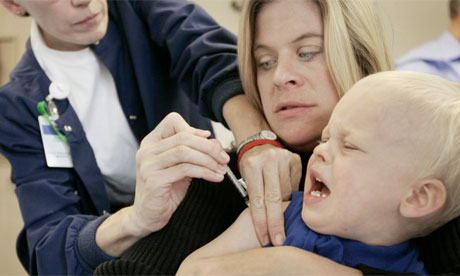
In a move that demonstrates health insurance companies' keenly cultivated moral bankruptcy, several of the country's largest insurers have announced that they would no longer sell child-only health policies. This was their response to the Affordable Care Act, which took effect last week.
The new law ensures that all pediatric well-child visits, including immunisations, hearing and vision screenings, must be covered. The new Patient's Bill of Rights also eliminates most lifetime limits on coverage, bans insurers from denying care to children with pre-existing conditions, and from dropping coverage when a child becomes ill. It was in response to these new regulations that several health insurance companies finally dug down to the cold depths of their compassionless souls and mined this gem: withholding new child-only policies from the individual private market.
This is perplexing because these policies make up only 10% of the market, but then again, every cent counts. Children make up 50% of the US Medicaid population, but they account for only 22% of total Medicaid expenditures. Each child costs an average of $1,856 per year, compared to the average annual annual cost per adult of $6,631. Yet, our insurance companies still think that the burden of ill children weighs too heavily on their corporate shoulders.
One loophole to the landmark law is that insurers still may impose lengthy waiting periods after a child receives a devastating diagnosis. An extended, arduous waiting period for a child newly diagnosed with leukemia can be just as catastrophic as denial of coverage. Anyone who has ever been put on hold while on the phone to an insurance company has a clue about how long this "waiting period" is likely to be. Your nine-year-old with leukemia is expected to pray for a miracle while the insurance company highlights your itemised bill. IV? Fine. Painkillers? Apologies, but budgets are tight this year.
Another ambiguity in the law allows insurers to impose a monetary cap on the sickest children's care, as long as this decision is made in good faith. Why shouldn't it be? Clearly, there's no conflict of interest. What if the mother whose child who needs a heart transplant were asked what the financial cap on her daughter's care should be? At least she is not plagued by the need to increase shareholder value, only by the desire to see her child reach her 10th birthday.
An estimated 11.4% of American children – 8.8 million – are uninsured. That number varies greatly from state to state. In Texas, 20% of children are uninsured. The question that is central to this debate remains: who are the uninsured? Many buy into the propagandised myth: the uninsured are the lazy, the unemployed, the lower-class, the ethnic immigrants. According to the department of health and human services, however, 48% of uninsured Americans are white. Hispanics do have a higher uninsured rate proportionally, but research has found that this is because they are more likely to be employed in jobs that do not offer health insurance, such as construction and agriculture.
The great majority (79%) of the uninsured are US citizens. In 2004, almost half the uninsured (46%) worked full-time, and 28% worked part-time. They remain uninsured largely because their companies do not offer health coverage.
One reason that Texas, for instance, has so many uninsured is not because they are all unemployed "Messicans", but because the economy depends upon small businesses, which cannot afford to provide their employees with insurance. These employees make too much to qualify for Medicaid, and there are no unions in place; hence, very large numbers of working-class people remain uninsured.
In order to qualify for Medicaid, one can earn up to 185% of federal poverty level, which is around $22,000 in most states. So, if your family of four makes more than $40,700, you don't qualify for Medicaid. The cheapest healthcare for a family costs around $13,000 per year, which poses the question for middle-class families: would you rather feed your kids or insure them? I wouldn't spend a third of my paycheck on health insurance.
So, who are the uninsured? Working-class US citizens. They are not lazy; they're smart, and they're trying to make ends meet. The uninsured aren't "they". They're us. It's our children who are being deprived of even basic treatments, such as antibiotics.
How tragic that the richest, most prosperous country in the world is comfortable allowing its children to suffocate to death. Literally. Asthma, you see, is one of those pre-existing conditions in the fine print you missed, sir (or madam). Breathing treatments may or may not be part of your preferred plan. While we look into that matter, please, just listen to Mariah Carey while you wait on hold and watch your child asphyxiate.

